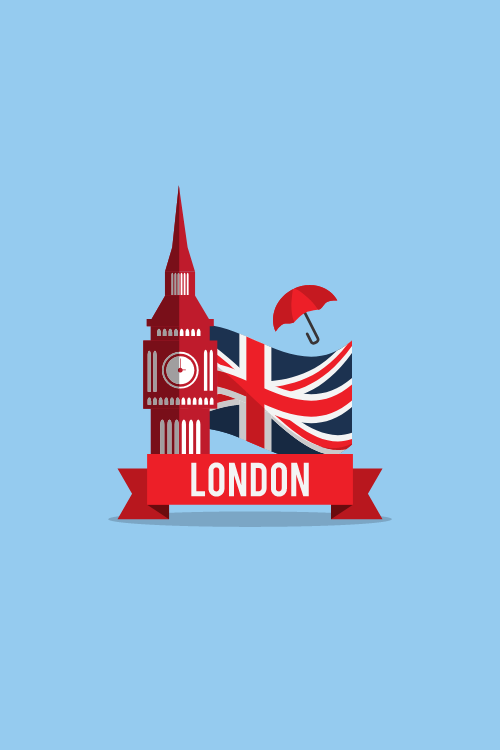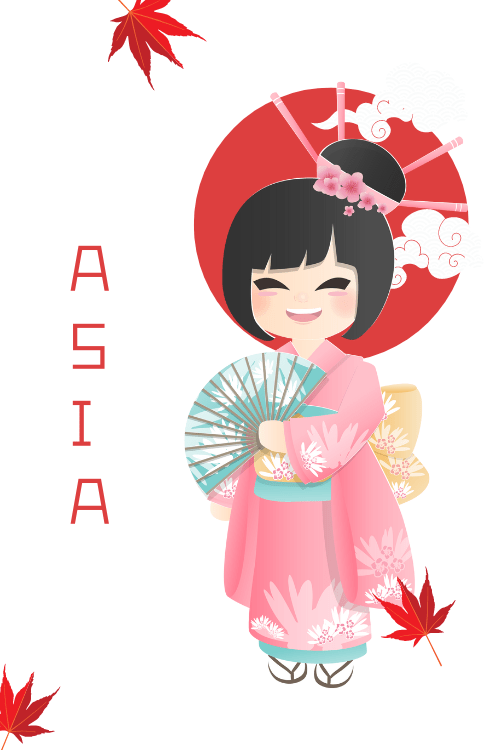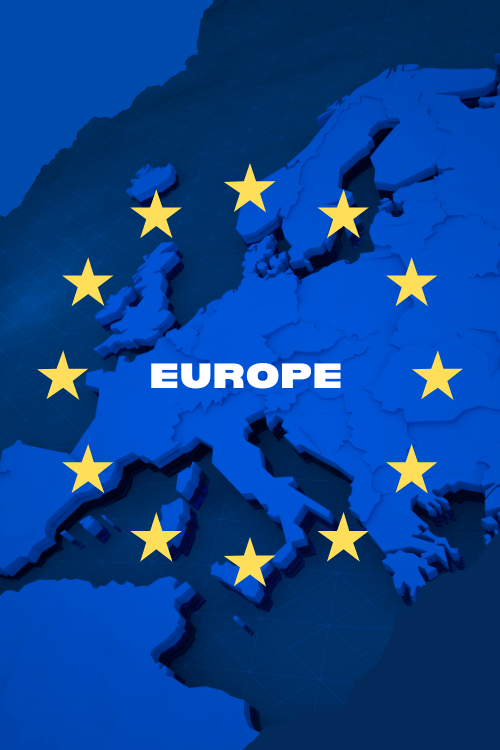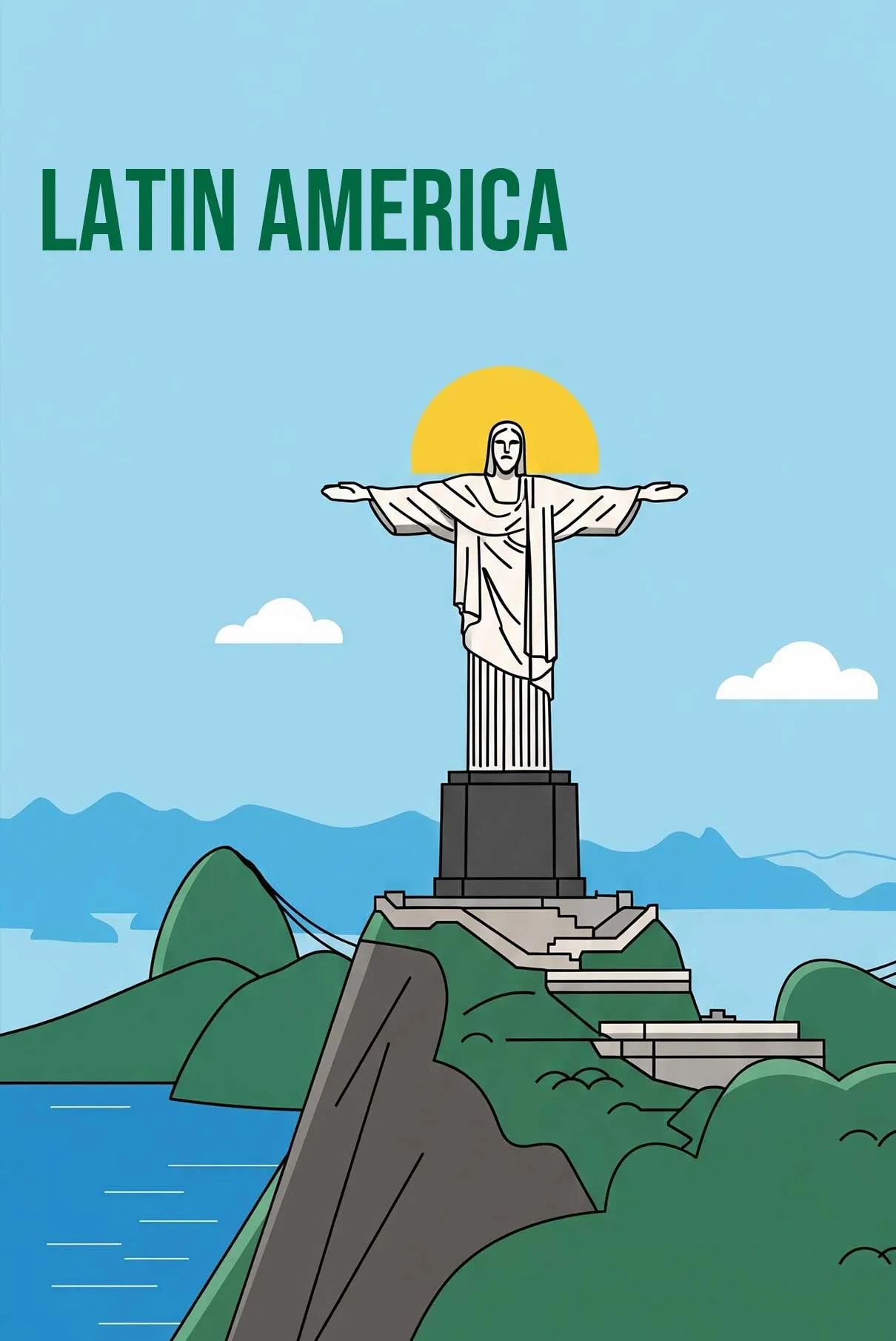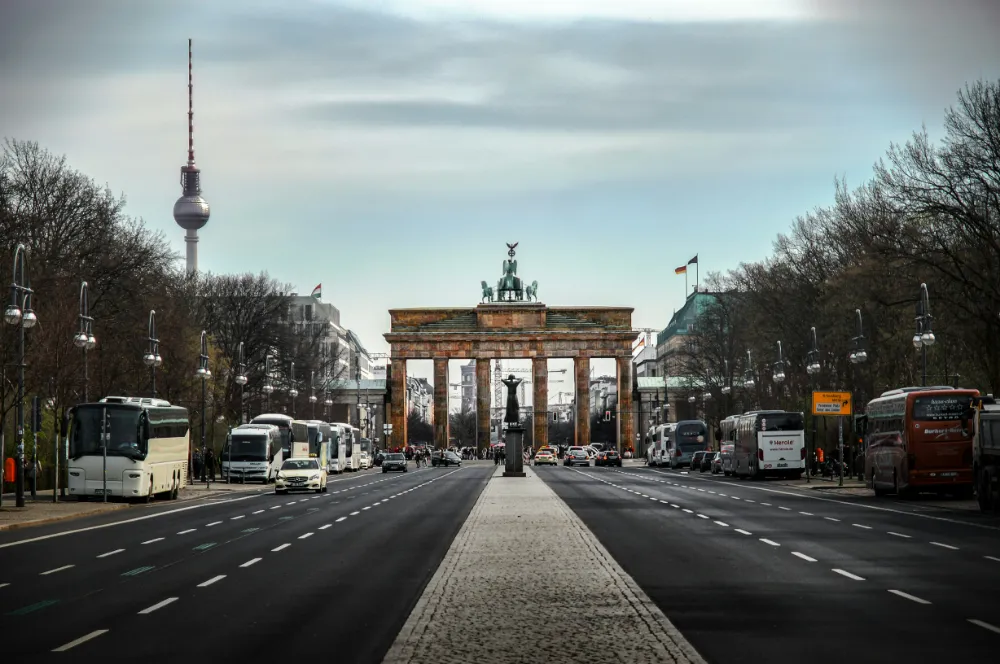Best Time To Visit, eSIM Germany
Best Time To Visit Germany: Weather, Activities, Our Top Season Picks
Germany is a country packed with vibrant cities, fairytale castles, and stunning nature that really shifts its personality with the seasons.
Picking the best time for your German adventure is about more than just a quick weather check. It’s about matching your travel dreams with what Germany’s like throughout the year – from its weather and crowd levels to all the cool cultural happenings.
Let’s break down what Germany offers each season, so you can find that perfect slot for your trip.
What’s the Weather Like? A Quick Look at Germany’s Seasons
Germany generally has a pretty mild climate, especially when you consider how far north it is. A big thanks for that goes to the North Atlantic Current, which shields it from the really extreme cold. But “mild” doesn’t mean predictable! Super-hot summers or crazy long, cold winters aren’t the norm, but they can happen. You’ll find four distinct seasons here, and each one paints the landscape differently and offers a totally unique vibe for exploring.
Spring’s Big Reveal (March – May): From Chilly Starts to Full Bloom
Spring in Germany is pretty exciting. It’s when the country slowly shakes off winter and edges towards warmer days. The weather can be a real mixed bag, so flexibility with your plans (and your packing!) is key. Think average temperatures bouncing between 5°C and 15°C (that’s 41°F to 59°F). But that’s just an average. March can often still have a wintery feel, especially up in the mountains. April might surprise you with a cold snap one day and warm sunshine the next. By May, you’re often into genuinely warm, T-shirt weather.
Early spring, particularly March and sometimes into April, can still have those “almost permanent overcast” skies you often hear about in German winters. Sunshine gradually picks up, but expect some rain showers. Interestingly, even with spring’s reputation for unpredictable rain, places like Berlin, Brandenburg, and Hesse often see fewer rainy days in April. This could make it a good bet for city trips if you’re after drier (though not always warm) conditions. It’s a bit different from the usual advice to wait for May’s warmth, though May can also surprise you with rain, especially somewhere like Munich.
Different areas feel spring differently too. Coastal spots might stay cooler for longer, while sheltered southern valleys warm up quicker. There’s an old weather saying, die drei Eisheiligen (“the three ice saints”), that hints at a possible cold snap in mid-May – a good reminder that frost can still be a thing. While it’s mostly a farming tip, it’s handy for travelers planning outdoor stuff. It suggests the second half of May is when you’re more likely to get stable, pleasantly warm weather.
Despite the changeable weather, spring feels fresh and new. Parks and gardens explode with color – cherry blossoms in cities like Bonn are a real treat. Outdoor cafes start setting up tables again, inviting everyone to soak up the stronger sun. And culturally? Spring brings Frühlingsfeste (Spring Festivals) to cities like Stuttgart and Munich, which are lively chances to dive into local traditions.
Summer’s Shine (June – August): Sunshine, Festivals, and Outdoor Fun
Summer is prime time for tourists in Germany, and it’s easy to see why. You usually get the warmest weather of the year and those lovely long, light days perfect for getting out and about. The atmosphere is buzzing with festivals and outdoor activities. Temperatures typically hover between 19°C and 21°C (66°F to 70°F), with daytime highs often hitting the 20s Celsius (70s to low 80s Fahrenheit). Cities further inland can get pretty humid, though, and the season isn’t always a guaranteed sunshine fest; surprise thunderstorms or even rainy spells can roll through. Cities like Frankfurt, Berlin, and Hamburg can all have their share of wet summer days.
This brings up an interesting point about German summers: while it’s generally the sunniest period (June and July often win for sunshine hours), these months can also be some of the wettest if you’re looking at total rainfall. It seems summer rain often comes in heavy, short bursts or thunderstorms, rather than the long, grey drizzle you might get in other seasons. The upside of long daylight hours? Even with a bit of rain, there’s usually plenty of time for activities. Plus, those showers help keep everything green and lush.
Different regions mean different summer vibes. The coasts along the North and Baltic Seas are cooler and breezier – a welcome break from the humidity in inland cities. Think of it as natural air conditioning! If you’re not a fan of heat and humidity, sticking to these coastal areas or the higher bits of the Bavarian Alps could be a smart move. The Bavarian Alps are amazing for hiking then, with pleasant daytime temperatures (20-30°C) that cool down nicely at night. River valleys like the Rhine, on the other hand, can get particularly warm.
Overall, German summer feels alive and energetic. It’s the season for enjoying outdoor cafes, sprawling beer gardens, river cruises, bike rides, hiking, and swimming in the country’s many lakes. The cultural calendar is also jam-packed, with music festivals and local celebrations popping up all over.
Autumn’s Golden Glow (September – November): Harvests, Crisp Air, and Culture
Autumn, especially early autumn (September to October), often gets the vote from seasoned travelers and locals as one of the absolute best times to visit Germany. This period frequently hits a sweet spot: lovely weather, stunning fall colors, and noticeably fewer crowds than in the summer frenzy. Autumn temperatures can vary quite a bit, from around 5°C to 16°C (41°F to 61°F).
September, in particular, often shines. It can hang onto much of summer’s warmth, with daytime highs potentially reaching the low 20s Celsius (low 70s Fahrenheit) and plenty of sunshine.
This time is often called Goldener Herbst (“Golden Autumn”) for its clear light and vibrant leaves. Many agree September is a fantastic mix: the tail end of good summer weather plus the early perks of shoulder season, like fewer people and maybe better prices (unless there’s a big event on). This makes September a really strong contender for a well-rounded German trip.
As autumn rolls into October, temperatures start to dip. The colorful leaves are still a huge draw, but you might get more wind and rain. November usually signals a clearer shift towards winter. Grey skies become more common, and daytime highs drop into the single digits Celsius (around the 50s Fahrenheit). This month also tends to mark the beginning of that “almost permanent overcast” that can stick around through winter.
So, “autumn” isn’t all one thing. Early autumn (September, early October) is often an ideal travel experience, very different from late autumn (November). November feels much more like early winter, atmosphere and weather-wise, just without the widespread holiday cheer of the Christmas markets that kick off later in the month or in early December.
Regional highlights in autumn?
Definitely the famous wine regions along the Rhine and Moselle rivers. They become hotspots for harvest festivals, with vineyards turning gorgeous shades of gold and red.
The Black Forest is also incredibly beautiful this season, offering a different kind of autumn magic. Culturally, Munich’s Oktoberfest dominates, starting in late September and spilling into the first few days of October, pulling in massive international crowds.
Beyond Oktoberfest, numerous wine festivals celebrate the grape harvest nationwide.
The crisp, pleasant air and the general drop in tourist numbers compared to summer make for more relaxed and comfy sightseeing.
Winter’s Embrace (December – February): Festive Sparkle, Snowy Escapes, and Cozy Comforts
Winter gives Germany a unique feel. You’re looking at cold temperatures, shorter daylight hours, and generally a quieter tourist scene. But this quiet is beautifully interrupted by the magical glow of Christmas markets in December and chances for awesome winter sports, especially in the mountains.
Average temperatures usually hover around 1°C to 2°C (34°F to 36°F), often dipping below freezing, particularly at night and throughout January and February (often the coldest months). Snow is common, especially in the Bavarian Alps which transform into a winter sports paradise, but it can blanket cities and countryside elsewhere too.
Winters, particularly at higher altitudes, can be long and very cold.
A big thing to know about German winters – and it’s often overlooked – is the “almost permanent overcast.”
This means for long stretches, sometimes months, you might see very little sunshine. This lack of light, even more than the cold itself, can really shape your travel experience and how things look during daytime explorations.
Rain or snow during these months can be, well, rain, freezing rain, or snow, with December often racking up the most days of precipitation in many German regions.
Despite the often grey and cold conditions, winter has two distinct phases. Late November through late December is all about the festive charm of Weihnachtsmärkte (Christmas markets).
These markets, popping up in almost every town and city (Nuremberg, Dresden, Cologne, Hamburg, and Kiel have some especially famous ones), create a lively, albeit temporary, peak in the low season. They draw in loads of locals and international visitors, pushing up demand for hotels and prices in popular market cities.
Once the holidays wrap up, January and February usher in a quieter, more thoughtful winter. This period, outside of alpine ski resorts (which have their own busy season from January to March), is the true low season for tourism.
It’s perfect for uncrowded museum visits, exploring indoor historical sites, and soaking up the cozy vibe of traditional German cafes and pubs.
The Bavarian Alps, during these months, are prime for skiing and snowboarding, with a season typically running December through March. February is often singled out as being especially snowy in these mountain areas. Coastal regions, meanwhile, will be cold, damp, and often windy.
If you’re a budget-conscious traveler hunting for the lowest prices and fewest fellow tourists, January and February (excluding ski resorts) or November (before the Christmas market buzz really kicks in) are your best bets.
Table 1: Germany’s Seasons at a Glance: Weather & Vibe
| Season | Typical Months | Avg. Temp Range (°C/°F) | Typical Rain/Snow | Sunshine Hours (General Feel) | Key Vibe & Highlights |
| Spring | March – May | 5-15°C / 41-59°F (variable, warmer in May) | Showers likely, April often drier in many areas | Increasing | Blooming nature, Spring Festivals (Frühlingsfeste), outdoor cafés reopening |
| Summer | June – August | 19-21°C / 66-70°F (can be hotter inland, cooler coasts/Alps) | Sunny spells, possible thunderstorms, humid inland | Plentiful, long days | Lively festivals, outdoor fun, beer gardens, peak tourist time |
| Autumn | September – November | 5-16°C / 41-61°F (Sept often warm, Nov much cooler) | Crisp days, fall colors, some rain (esp. later) | Decreasing, Nov often grey | Wine harvests, Oktoberfest, beautiful foliage, fewer crowds than summer |
| Winter | December – February | 1-2°C / 34-36°F (often freezing, esp. Jan/Feb) | Overcast, snow/rain/freezing rain, esp. Dec | Limited, often grey | Christmas markets (Dec), cozy indoors, alpine skiing, quietest overall season |
When to Go? Navigating Germany’s Tourist Seasons
Getting a handle on Germany’s tourist seasons is super helpful for planning. It directly impacts how crowded places are, what you’ll pay for hotels and transport, and your overall experience. These seasons are shaped by more than just weather – holidays and big events play a huge part.
The Peak Buzz: Germany in High Season
Germany’s high season generally means summer: June through August. This often stretches to include the mega-popular Oktoberfest in late September/early October, especially for Munich. The festive Christmas period from mid-December through New Year’s Day across the country also counts as peak time. May often feels like peak season too, thanks to its usually great weather and growing visitor numbers.
What’s the big draw for peak season? For many, it’s the weather. These months usually offer the warmest temperatures and the most sunshine – ideal for all sorts of outdoor activities and sightseeing. Summer also boasts long daylight hours, giving you more time to explore. The cultural calendar is buzzing with festivals, outdoor concerts, and local celebrations.
But, these perks come with downsides. Expect popular spots, big cities like Berlin, Munich, and Frankfurt, and major attractions to be very busy. That often means long queues. Prices for hotels and flights will be at their highest. So, booking well ahead isn’t just a good idea; it’s often essential to get what you want and avoid being disappointed. Peak season is a big hit with families on school holidays, festival-goers, and anyone whose main goal is warm-weather fun like hiking, cycling, and swimming.
Heads up: major events can really crank up and extend the traditional summer peak. Oktoberfest, for example, turns Munich into a global hotspot. Hotel prices skyrocket, and rooms vanish months in advance.
Similarly, Germany’s Christmas markets cause a concentrated surge in visitor numbers and hotel demand in popular market cities during December. This means you can’t just assume shoulder months like September or all of December will be quiet or cheap. It’s crucial to check for specific events if your dates are near these major happenings, as they can totally change your on-the-ground experience.
The Shoulder Season Sweet Spot: Great Value and Views
The shoulder seasons in Germany – usually April and May in spring, and September through mid-to-late October in autumn – are a fantastic alternative to the busy peak months. March and November also often pop up as budget-friendly off-peak or shoulder options, giving more choice if you’re watching your pennies.
These transitional times often strike a nice balance. Spring weather, especially in April, can be famously unpredictable – you might get sunshine, rain, hail, and even a bit of snow in a short space of time! May, however, generally settles into more consistently pleasant conditions. Autumn, particularly September, often brings crisp air, plenty of sunshine, and those gorgeous fall colors. The lower prices and fewer crowds of the spring shoulder season can be seen as a direct trade-off for this weather lottery. The risk of less-than-perfect weather keeps some folks away, leading to lower demand and better deals. If you’re willing to roll with that unpredictability, pack for it, and be flexible, you can save a good chunk of money and have a more relaxed trip.
One of the biggest advantages of the shoulder seasons is way fewer tourists compared to summer. Think quieter city centers, shorter (or no!) lines at major sights, and a generally more peaceful vibe for sightseeing. For budget travelers, these times are especially golden, with generally lower rates for hotels and flights. September, as we’ve mentioned, consistently gets rave reviews, often blending leftover summer warmth with the early perks of the shoulder season. So, shoulder seasons are well-suited if you’re looking for a good mix of decent weather, fewer people, better value, and plenty of chances for cultural exploration.
The Quiet Charm of Low Season: Finding Gems Beyond the Crowds
Germany’s low season generally runs from November through March, with the busy Christmas holiday period (mid-December to early January) being an exception. This timeframe means cold weather, much shorter daylight hours, and often cloudy skies.
The main appeal? It’s quiet and more affordable. This is usually the least busy time of year to visit, with the fewest tourists at most attractions. This is especially true for January and February, after the Christmas market crowds have gone and before spring starts to stir. As a result, this period is often the most wallet-friendly. You’ll find noticeably lower prices for flights and hotels, as long as you steer clear of the mini-peaks around popular Christmas market cities in December or ski resorts during their busy season.
While the weather can be, let’s say, “less than ideal for spending ages outside,” especially during the damp cold of deep winter, this very fact nudges visitors towards Germany’s fantastic indoor cultural offerings. January and February can be surprisingly rewarding if you’re mainly interested in art, history, museums, and soaking up the cozy Gemütlichkeit of traditional German cafes and pubs. No long lines or crowded exhibition halls mean a more personal and unhurried experience with these cultural treasures. So, the “bad weather” can actually lead to a different, but equally enriching, kind of trip. This season is great for budget travelers, those after peaceful and cozy getaways, dedicated museum fans, and anyone wanting to see Germany’s cities and towns without the usual throngs.
Table 2: Germany’s Travel Seasons: Crowds & Costs
| Travel Season | Typical Months (incl. event peaks) | Crowd Levels (Major Cities/Sights) | Price Guide (Flights/Hotels) | Key Upsides | Key Downsides |
| Peak Season | May – Aug; Oktoberfest (late Sep/early Oct); Christmas (mid-Dec – New Year) | Very High | $$$$ | Often best weather, many festivals, long daylight hours (summer) | Highest prices, biggest crowds, booking way ahead is a must |
| Shoulder Season | Apr – May; Sep – mid/late Oct; (Mar & Nov for budget) | Moderate to Low | –$ | Fewer crowds, better value, often pleasant weather (esp. May, Sep), fall/spring beauty | Unpredictable weather (esp. spring), some sights might have shorter hours |
| Low Season | Nov – Mar (excluding Christmas peak & prime ski resort time) | Low | $$ | Lowest prices, fewest crowds, cozy vibe, good for indoor culture | Cold/dark weather, overcast skies, shorter daylight, some things might be closed |
Planning Your Perfect Trip: Germany by Travel Style
The “best time” to visit Germany really clicks into place when you think about what you love to do. Different activities and interests just fit better with certain seasons.
For City Explorers & Culture Buffs: Best Times for Urban Adventures
Germany’s cities, bursting with history and culture, are great year-round. But some periods offer that sweet spot for exploring. Spring (especially April and May) and autumn (particularly September and October) are often recommended as ideal. These months usually bring mild, comfortable weather – perfect for walking tours and soaking up city life. Plus, way fewer crowds than the summer peak mean a more relaxed and engaging time at museums, historical sites, and famous landmarks. In spring, city parks are vibrant with blooms, while autumn drapes the urban scene in golden leaves, adding to the beauty.
Summer (June to August) has its own perks for city sightseers. Long daylight hours are a clear win, giving you more time to pack things in. City atmospheres are often at their liveliest, with outdoor cafes, street performers, and loads of cultural events creating an energetic buzz. However, this energy can come with potentially hot and humid weather in some cities, plus the biggest tourist crowds of the year. That can mean queues and a quicker pace at popular spots.
Winter offers a different take on city culture. The Christmas market season (late November through December) is a unique cultural dive, turning city squares into festive wonderlands. Beyond the markets, the deeper winter months of January and February have even fewer tourists, making it an excellent time for unhurried visits to Germany’s world-class museums and galleries. The cold weather naturally encourages cozy indoor time, helping you appreciate the country’s rich cafe culture.
Ultimately, if you’re a city sightseer, you might be choosing between summer’s high-energy buzz and the more comfortable, less crowded exploration of the shoulder and winter seasons. If a lively outdoor city experience is top of your list, summer’s attractive. If a more thoughtful, comfy time with art and history is the priority, shoulder seasons or even deep winter are great choices.
For Nature Lovers & Adventure Seekers: When to Hike, Cycle, and Hit the Alps
Germany’s diverse natural landscapes – from rolling hills and dense forests to towering alpine peaks – are a playground for outdoor enthusiasts. The best timing really depends on your activity and where you’re headed.
For general hiking, summer (June-August) is often seen as perfect due to reliable warmth and long daylight. However, spring (April-May) and autumn (September-October) are also excellent. Keen hikers often prefer these times for their milder temperatures, which can be more comfortable for strenuous treks.
The Black Forest, a famous hiking paradise in southwestern Germany, has its own rhythm. While guidebooks often flag spring and autumn as top seasons for hiking and cycling here, summer (May to September) is also enjoyable. The forest’s cool shade keeps walks manageable even on warmer days. What’s really important for hikers here is to know about seasonal trail closures in the Black Forest National Park (northern Black Forest). Some trails shut down from November 15th and gradually reopen on March 15th, May 15th, or even as late as June 15th. This is mainly to protect wildlife during sensitive times. So, for serious hikers, aiming for late spring (after most trails have reopened) or early to mid-autumn (before winter closures kick in and to catch the fall colors) probably offers the best combo of comfy temperatures, open trails, and beautiful scenery.
For cycling, including popular routes like the Danube Cycle Path, May to September is generally considered ideal. Temperatures are usually good for pedaling, and the landscapes are at their most vibrant. However, July and August can bring very hot days, possibly over 32°C (90°F). These months also coincide with school holidays in Germany and nearby countries, meaning more families and potentially busier cycle paths.
Alpine activities in the Bavarian Alps follow a clear seasonal pattern. Hiking is best from late spring (once snow has melted at lower and mid-altitudes) through autumn (before the first big snowfalls). The snow line in the Alps typically rises to around 2,000 meters in March and above 3,000 meters from June, directly impacting whether high-altitude trails are accessible. The Foehn, a warm, gusty wind from the Mediterranean, can also affect Alpine weather, sometimes bringing unusually warm, clear conditions, but also rapid changes. Skiing and other winter sports are popular from December to March, with February often being especially snowy.
It’s clear that for specific outdoor regions and activities, general seasonal advice might not cut it. Things like local trail closures, when snow melts at high altitudes, or even school holiday schedules can create “micro-seasons” of suitability. If you’re passionate about certain outdoor activities, it’s smart to supplement general seasonal advice by digging into local conditions and rules for your chosen dates and specific region.
For Festival Fans: Timing Your Trip with Germany’s Big Events
Germany’s calendar is packed with an amazing variety of festivals that draw huge crowds and shape the cultural scene. Planning a visit around these needs careful thought about timing, location, and how they affect crowds and prices.
Perhaps the most famous globally is Munich’s Oktoberfest. This massive beer festival traditionally kicks off in late September and runs until the first Sunday in October (or October 3rd, German Unity Day, if it’s later). This event transforms Munich. Hotel prices soar, and rooms book out months, sometimes even a year, ahead. If Oktoberfest isn’t your main reason for being in Munich then, it’s often best to pick different dates or places.
Christmas Markets (Weihnachtsmärkte) are another huge draw, creating a magical atmosphere in towns and cities nationwide from late November through Christmas Eve (some last a bit longer). Famous markets in cities like Nuremberg, Dresden, Cologne, Hamburg, and Kiel attract enormous numbers of visitors, leading to increased demand for hotels, especially on weekends and closer to Christmas.
Wine Festivals are a highlight of late summer and autumn, especially in Germany’s renowned wine-producing regions like the Moselle, Rhine, Franconia, and Nahe. The main season for these lively celebrations of the grape harvest usually runs from August through October. Many specific events, like the Dürkheimer Wurstmarkt (often called the world’s largest wine festival, usually in September), Mythos Mosel (June), and Saar Riesling Summer (August), offer fantastic tasting and cultural experiences.
Summer is definitely peak season for Music Festivals, catering to a wide range of tastes. Major events like Wacken Open Air (heavy metal, usually August), ParookaVille (electronic dance music, July), Nature One (electronic, August), and M’era Luna (gothic, August) pull large crowds to various locations, mostly between June and August.
Spring has its own celebrations with Frühlingsfeste (Spring Festivals). These are basically smaller versions of Oktoberfest, celebrating Bavarian culture with beer tents, carnival rides, and traditional food in cities like Stuttgart and Munich. Earlier in the year, usually in February or early March, the Carnival season – known as Fasching, Karneval, or Fastnacht depending on the area – brings colorful parades, costumes, and lively parties, mainly to Rhineland cities like Cologne, Düsseldorf, and Mainz.
These major festivals create their own intense, local peak seasons. Even if a month like September is generally seen as shoulder season, a city like Munich during Oktoberfest will be far busier than a typical summer peak. This shows why you need to check your planned travel dates against major festival calendars for your chosen destinations. Stumbling into a city during a major festival without knowing can lead to big logistical and budget headaches if it’s not what you came for. On the other hand, if the festival is your trip, then these are, of course, the perfect times to visit!
Table 3: Calendar of Major German Festivals & Events
| Event Type | Key Event Name(s) | Typical Dates/Month(s) | Primary Location(s)/Region(s) | Brief Vibe |
| Beer Festival | Oktoberfest | Late Sep – Early Oct | Munich | World’s biggest beer fest, traditional Bavarian, very crowded, festive, pricey. |
| Frühlingsfest (Spring Festival) | Spring (Mar-May) | Stuttgart, Munich, other cities | “Little Oktoberfest,” beer tents, carnival rides, lively. | |
| Wine Festivals | Dürkheimer Wurstmarkt, Mythos Mosel, various Weinfeste | Aug – Oct (peak); some earlier | Wine regions (Moselle, Rhine, Pfalz, Franconia, etc.) | Celebrating grape harvest, wine tasting, local food, music, friendly. |
| Christmas Markets | Christkindlesmarkt (Nuremberg), Striezelmarkt (Dresden) | Late Nov – Late Dec | Nationwide (major cities & small towns) | Festive lights, crafts, mulled wine (Glühwein), traditional food, magical. |
| Music Festivals | Wacken, Rock am Ring, ParookaVille, M’era Luna, Nature One | June – Aug (mainly) | Various locations nationwide | Diverse genres (rock, metal, electronic, pop, goth), large crowds, energetic. |
| Cultural/Seasonal | Karneval/Fasching (Carnival) | Feb / Early Mar | Rhineland (Cologne, Düsseldorf, Mainz), some southern areas | Street parades, costumes, parties, pre-Lent fun. |
| Carnival of Cultures (Karneval der Kulturen) | Pentecost weekend (Spring) | Berlin | Multicultural street parade & festival, vibrant, diverse. | |
| Kiel Week (Kieler Woche) | Late June | Kiel | World’s largest sailing event, maritime festival, concerts. |
For the Savvy Budget Traveler: Getting the Most Bang for Your Buck
You can absolutely explore Germany without emptying your wallet, as long as you time your travel smartly to hit those times with lower demand and better prices. The shoulder seasons and the true low season (outside specific event rushes) are your best friends here.
The shoulder seasons – generally March to May and October to November – are consistently recommended if you want your travel budget to stretch further. During these months, prices for hotels and flights are usually lower than in the peak summer months. While the weather, especially in spring, can be a bit of a gamble, it’s often perfectly manageable. The significantly fewer crowds at popular attractions also make for a more relaxed and cost-effective sightseeing experience.
For the biggest savings, the low season, typically from November through March, is the top choice. This period generally has the lowest prices for flights and accommodation. However, it’s important to be aware of the “mini-peaks” within this season. The Christmas market period in December, while magical, can drive up prices in popular market cities, especially on weekends and during the weeks closest to Christmas. Similarly, ski resorts in the Alps have their own high season from January to March, with corresponding price hikes.
So, for the truest budget experience, aim for November (before the Christmas market season really gets going), or January and February (after the New Year’s rush and outside of prime ski resort areas). Early December can also be a sweet spot if you want to experience the Christmas markets without the absolute peak crowds and prices; visiting on weekdays in early to mid-December might offer a more manageable and slightly cheaper market visit. While these months are the coldest and often the greyest, the money saved can be significant, perhaps allowing for a longer stay or more to spend on other parts of your trip.
Regional Rhythms: When to Explore Germany’s Diverse Areas
Germany’s varied landscapes mean the “best time to visit” can also really depend on the specific region you’re eyeing up. From the alpine south to the maritime north, each area has its own weather personality and seasonal highlights.
Bavaria & The Alps: Alpine Blooms to Winter Wonderlands
Bavaria, especially its stunning Alpine region, is a land of dramatic seasonal shifts and is, on average, Germany’s coldest region. Its climate is shaped by both continental and Alpine factors, meaning warmer summers and noticeably colder, snowier winters than northern Germany. While Bavaria’s average daily high is around 13°C (55°F), the summer months (May to September) bring pleasantly warm conditions perfect for outdoor fun. Daytime temps often range from 20°C to 30°C (68°F to 86°F), cooling down nicely at night. Winters (December to February) mean reliable snowfall, especially higher up, creating a paradise for skiing.
For hiking and general outdoor activities in the Bavarian Alps, May (once lower snow has melted) through September or even October is generally best. The ski season typically runs from December to March, with February often being particularly snowy.
Munich, Bavaria’s lively capital, has its warmest months in June, July, and August (average daily mean around 19°C/66-67°F). January and December are coldest (average daily means 1°C-3°C/34-38°F). Munich sees most rain in May, June, and August, while its sunniest months are June through August. For sightseeing in Munich and exploring Bavaria’s famous castles like Neuschwanstein, the shoulder seasons of April-May and September-October offer fewer crowds than summer. Summer itself is perfect for Munich’s beer gardens. And, of course, late September to early October is all about Oktoberfest.
Berlin & Brandenburg: A Metropolis for All Seasons
The capital region of Berlin and surrounding Brandenburg usually means cold winters, genuinely hot summers, and milder spring and autumn transitions. Berlin’s weather can be famously unpredictable! The average annual temperature is around 11°C (52°F), with July being warmest (average 20°C/68°F). June gets the most sun (about 9 hours/day), while December sees the least. Rain-wise, December tends to have the most rainy days, while April often has the fewest. Interestingly, while April is drier in frequency, July often gets the highest total rainfall, suggesting Berlin’s summer rain can come in heavier, shorter bursts.
For general sightseeing in Berlin, May to September is often recommended for warmer temps. However, spring (April-May) and autumn (September-October) are also very popular for milder weather and significantly fewer crowds than the summer peak, making for more comfortable exploring. Berlin’s event calendar is full year-round, with highlights like the Carnival of Cultures in summer, the Berlinale Film Festival in February, numerous summer open-air festivals, and, of course, enchanting Christmas markets.
Hamburg & The Northern Coasts (North Sea & Baltic Sea): Maritime Charms
Northwestern Germany and its coasts along the North Sea (Nordsee) and Baltic Sea (Ostsee) have a distinct maritime climate. This means summers are generally warm but rarely too hot, and winters are milder and cloudier than inland. Being near the sea also means higher humidity and more frequent rain year-round. Prevailing westerly winds are a big feature, bringing moist air and often-changing weather.
The North Sea coast typically sees summer averages around 20°C (68°F) and winter temps around 5°C (41°F). It’s also prone to storms and strong winds, especially in winter. The Baltic Sea coast tends to have cooler summers (around 15°C/59°F) and colder winters (can drop to -2°C/28°F), generally with more snow than the North Sea. Coastal winds are a mixed bag: they moderate temperatures but also mean more rain and a rugged feel, especially outside summer.
For beach holidays, May to September offers the warmest air temperatures (21°C-28°C/70°F-82°F), though water temps rarely top 21°C (70°F).
Hamburg, Germany’s second-largest city, is known for being fairly wet and windy. Summers are warm but often rainy. Winters are cold (January averages around -2°C/28°F), and canals can freeze. Spring (April-May) is often highlighted as a great time to visit Hamburg, with parks blooming and milder, less crowded conditions than summer. Summer in Hamburg is lively but be ready for rain.
The Rhine & Moselle Valleys: Vine-Clad Slopes & Castle Cruises
The picturesque river valleys of the Rhine and Moselle, especially in southwestern Germany, often enjoy a milder microclimate. These can be among Germany’s hottest areas in summer. The Rhine Valley, in particular, is known for warmth and milder winters – great for its famous wine.
The wine calendar heavily influences visits here. While scenic from spring through autumn, late summer into autumn (August to October) is arguably richest culturally. It’s harvest time, with lively wine festivals, vineyards in stunning fall colors, and a celebratory buzz. If you love wine, aim for this period.
For cycling riverbanks or enjoying castle cruises, spring (May) through autumn (October) generally offers pleasant weather. For exploring charming towns and castles, spring and autumn mean mild temps and fewer crowds than summer. Quieter scenic beauty? Late spring or early summer could be perfect.
The Black Forest: Trails, Traditions, and Trees
The Black Forest (Schwarzwald) in southwestern Baden-Württemberg is all about dense forests, traditional villages, and hiking trails. Baden-Württemberg’s average annual temperature is 10°C (50°F) – July is warmest (average 19°C/66°F), January coldest (average 1°C/34°F). It usually gets most rain in May, least in March, while July has most sun (8 hours/day). For the Black Forest itself, summers are generally warm, winters can be cold, freezing, and wet, while spring and autumn are often cool, wet, and windy.
For hiking, its main draw, spring and autumn are often named best. Milder temps are comfier for long treks, and landscapes are bright with spring flowers or autumn colors. Summer (May-September) is also good for hiking; the forest’s shade helps. But remember those seasonal trail closures in the Black Forest National Park! Many trails close from November 15th, reopening gradually between March 15th and June 15th, mainly to protect wildlife. Some higher trails might also be snowy well into spring. So, for serious hikers, late spring (after most trails reopen) or early to mid-autumn (for good temps, fall foliage, and before winter closures) is likely the best bet. Winter offers snowshoeing and winter walking on marked trails – magical, but cold!
Your Definitive Guide: Nailing Down the Best Time for Your German Trip
Germany’s got so much to offer, making it a fantastic place to visit any time of year. The “best time” isn’t a one-size-fits-all answer. It’s really down to what matters most to you – weather, crowds, budget, what you want to do, and which specific bits of Germany you’re keen to see.
Quick Recap – Key Things to Ponder:
- For Great Weather & Outdoor Fun: Late Spring (May) through Summer (June-August), and into early Autumn (September), usually offer the nicest conditions. May means blooming landscapes and steady warmth. Summer brings long, sunny days. September often blends summer’s leftover warmth with early autumn beauty. Just remember peak summer crowds and prices, and the chance of summer showers.
- For Fewer Crowds & Good Value (Sightseeing Focus): The Shoulder Seasons – April, May, September, and October – get a big thumbs up. Usually far fewer tourists than peak summer, meaning more relaxed exploring. Hotel and transport prices are often better. September frequently shines as a top month, offering a superb mix of good weather and fewer people (except around Oktoberfest).
- For Tight Budgets: The biggest savings are usually found in November, January, February, and March. Just steer clear of the Christmas market peak in December and prime ski season in Alpine resorts if budget is your main driver. These months offer the lowest prices but also the coldest, often greyest, weather.
- For Christmas Markets: That magical window from late November through December is your time. Be ready for higher demand and prices in popular market cities, especially on weekends.
- For Oktoberfest: Munich, late September to early October. Book everything way in advance and expect peak conditions.
- For Wine Festivals: Main season is August through October, focused in wine regions like the Rhine and Moselle.
- For Hiking & Cycling: Generally, May through September/October works well. But check regional specifics, like Black Forest trail closures or Alps snow conditions.
- For Skiing: Alpine regions are great from December through March.
All things considered, September often pops up as a fantastic “sweet spot” for many travelers. It frequently delivers a wonderful mix of still-pleasant, late-summer weather, the start of beautiful autumn leaves, a noticeable drop in tourist numbers compared to July and August (again, Munich during Oktoberfest is the exception!), and the lively buzz of harvest festivals, especially in wine regions. Late spring, especially May, is another strong contender, offering blooming landscapes and generally lovely temperatures before the main summer rush.
Ultimately, Germany’s charm is always there. The key is matching what each season offers with your personal travel wishes. As the German saying wisely puts it, “There’s no such thing as bad weather—only bad clothing.” So, come prepared for Germany’s changeable climate, understand its seasonal rhythms, and you’re all set for an unforgettable adventure, whenever you choose to go!


